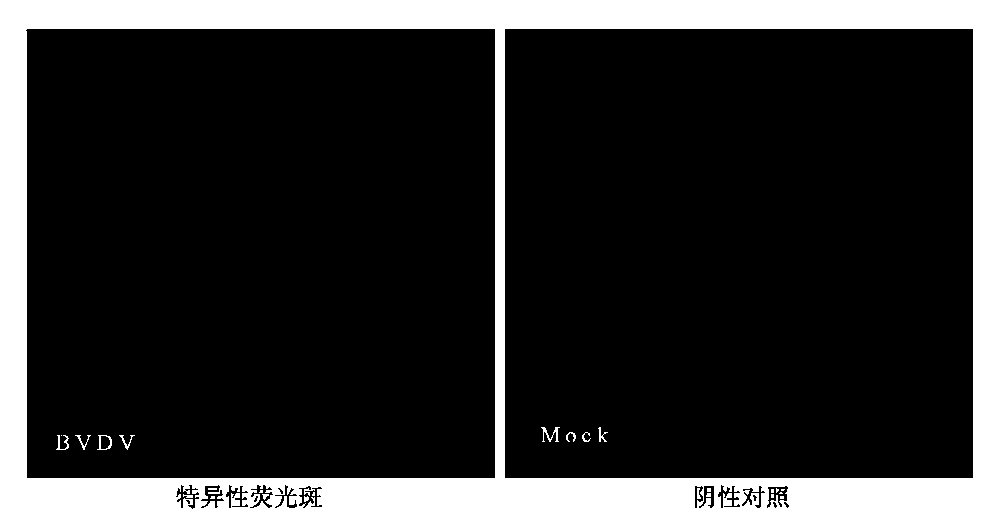Method for detecting bovine viral diarrhea virus by virtue of indirect immunofluorescence
A technology of bovine viral diarrhea and immunofluorescence, which is applied in the field of detection of bovine viral diarrhea virus by indirect immunofluorescence method, can solve the problems of inability to judge the infectivity of BVDV particles, and achieve accurate detection effect
- Summary
- Abstract
- Description
- Claims
- Application Information
AI Technical Summary
Benefits of technology
Problems solved by technology
Method used
Image
Examples
Embodiment 1
[0025] Example 1: A kind of method utilizing indirect immunofluorescence method to detect bovine viral diarrhea virus, it comprises the following steps:
[0026] S1. Culture of MDBK cells
[0027] MDBK cells were cultured in cell culture flasks in MEM medium containing 10% horse serum at 37°C in 5% CO 2 Cultured in a constant temperature incubator, subcultured once every 2 days, and a single layer of MDBK cells was overgrown. After digested with trypsin, add growth medium to make cell suspension at 2×10 5 Inoculate in a 96-well plate at a density of 1 / ml, 100 μl per well, and place at 37°C in 5% CO 2 Cultured under the condition of 24h, the cells adhered to the wall and covered the bottom of the well after 24h; wherein, the growth solution was MEM medium containing 10% horse serum;
[0028] S2. Inoculation of BVDV
[0029] Inoculate BVDV with the MDBK cells cultured in step S1, add 2% horse serum to 200 μl per well, and culture for 72 hours, and set MDBK cells not in...
Embodiment 2
[0036] Example 2: A kind of method utilizing indirect immunofluorescence method to detect bovine viral diarrhea virus, it comprises the following steps:
[0037] S1. Culture of MDBK cells
[0038] MDBK cells were cultured in cell culture flasks in MEM medium containing 10% horse serum at 37°C in 5% CO 2 Cultured in a constant temperature incubator, subcultured once every 3 days, full of monolayer MDBK cells. After digestion with trypsin, add growth medium to make cell suspension at 4×10 5 Inoculate in a 96-well plate at a density of 1 / ml, 100 μl per well, and place at 37°C in 5% CO 2 Cultured under the condition of 24h, the cells adhered to the wall and covered the bottom of the well after 24h; wherein, the growth solution was MEM medium containing 10% horse serum;
[0039] S2. Inoculation of BVDV
[0040] Inoculate BVDV with the MDBK cells cultured in step S1, add 2% horse serum to 200 μl per well, and culture for 72 hours, and set MDBK cells not inoculated with BVD...
Embodiment 3
[0047] Example 3: A kind of method utilizing indirect immunofluorescence method to detect bovine viral diarrhea virus, it comprises the following steps:
[0048] S1. Culture of MDBK cells
[0049] MDBK cells were cultured in cell culture flasks in MEM medium containing 10% horse serum at 37°C in 5% CO 2 Cultured in a constant temperature incubator, subcultured once every 2.5 days, full of monolayer MDBK cells. After digested with trypsin, add growth medium to make cell suspension at 3×10 5 Inoculate in a 96-well plate at a density of 1 / ml, 100 μl per well, and place at 37°C in 5% CO 2 Cultured under the condition of 24h, the cells adhered to the wall and covered the bottom of the well after 24h; wherein, the growth solution was MEM medium containing 10% horse serum;
[0050] S2. Inoculation of BVDV
[0051] Inoculate BVDV with the MDBK cells cultured in step S1, add 2% horse serum to 200 μl per well, and culture for 72 hours, and set MDBK cells not inoculated with BV...
PUM
 Login to View More
Login to View More Abstract
Description
Claims
Application Information
 Login to View More
Login to View More - R&D
- Intellectual Property
- Life Sciences
- Materials
- Tech Scout
- Unparalleled Data Quality
- Higher Quality Content
- 60% Fewer Hallucinations
Browse by: Latest US Patents, China's latest patents, Technical Efficacy Thesaurus, Application Domain, Technology Topic, Popular Technical Reports.
© 2025 PatSnap. All rights reserved.Legal|Privacy policy|Modern Slavery Act Transparency Statement|Sitemap|About US| Contact US: help@patsnap.com

